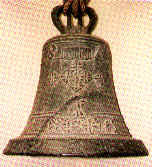|
|
Alta California's first mission was located just above Old Town and founded in 1769, by Father Serra. In 1774, the mission was moved to the valley for better water supply, farming and to separate Indians from soldiers.
Padres and Indians built the first dam in San Diego in 1813, 6 miles North-east of the mission. It was constructed of rocks and a cement made by burning lime in kilns. A tile aqueduct was constructed, to bring water to the mission and valley. Today, the dam site is historical landmark, known as "Old Mission" or "Padre Dom".
There are five bells in the tower of the mission. After secularization of the mission, in 1833, original bells were scattered, but eventually recovered and reinstated. In 1894, Father Ubach gathered up six bells, brought from New Spain, had them melted down and recast into one large bell, named "Master Dolorosa" (Our Lady of Sorrow), which is the 1200 pound bell on the lower right of the mission today.
Originally called "La Canada de San Diego" (The Glen of San Diego), the name was changed to "Mission Valley", around 1968. From 1880s to 1930s, twenty dairies gave Valley the reputation of being the dairy farming capital of San Diego, but ended in 1950, with the new Hwy 80.
By 1960, only six dairies were left. In 1978, the last remaining dairy, Ferrari Dairy, was demolished, leading the way to develop a major hotel base for San Diego. "Town & Country" was the first hotel, built in 1953.
The most valuable mineral resources to the county are also located here. In 1973, it was reported that close to $16 million worth of sand and gravel was produced and used in such items as concrete and asphalt.
In 1988, "Mission Valley Shopping" ranked third in size to all others in the county.

|
|

